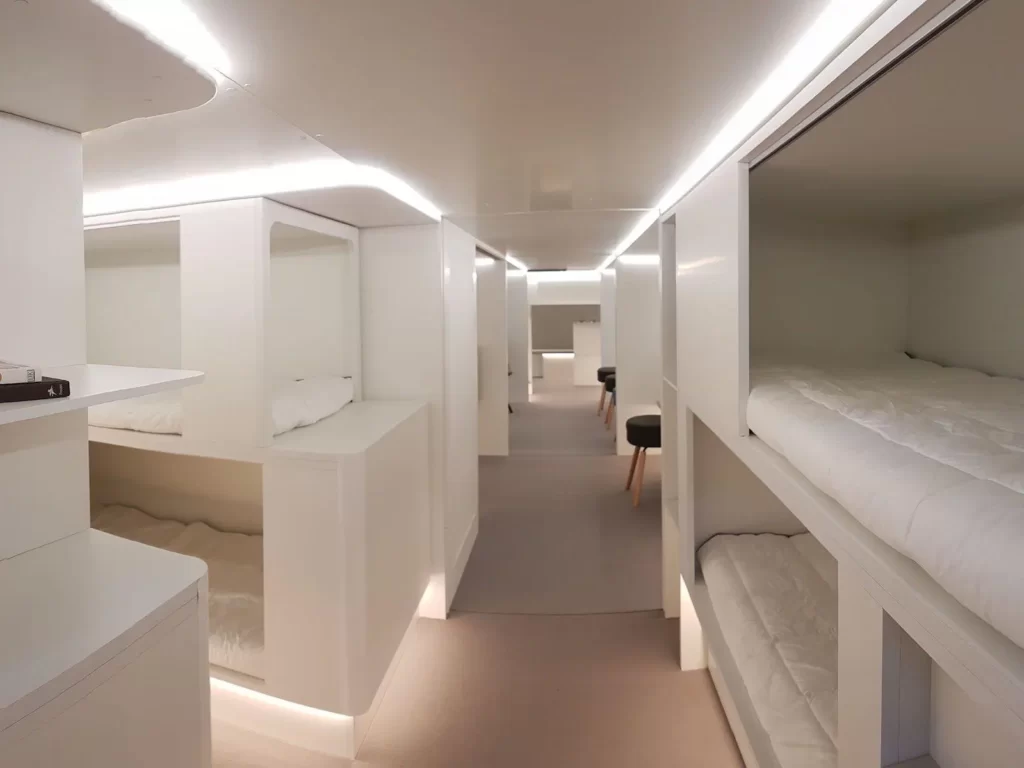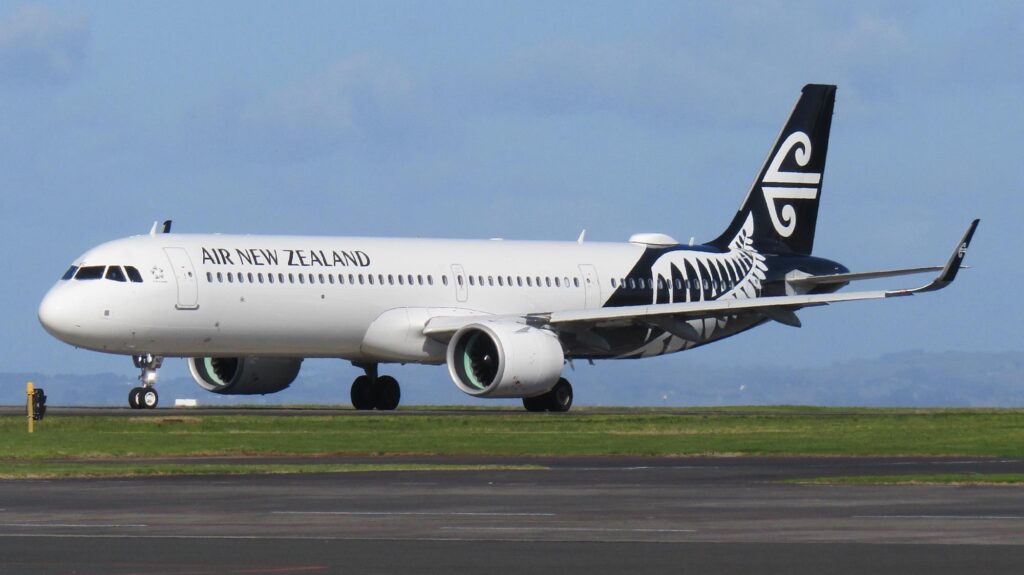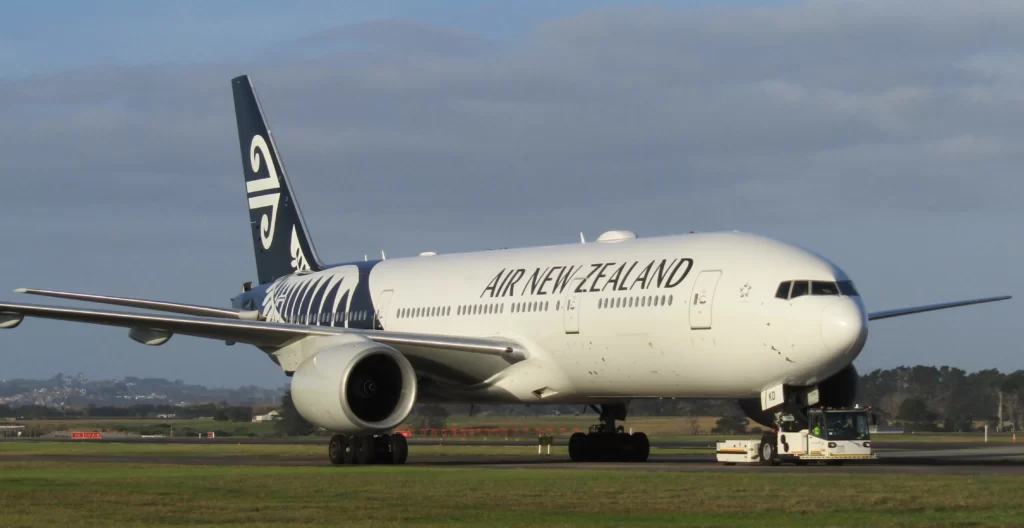Air New Zealand will soon permit economy passengers to lie down and take a nap in communal, bunk bed-style sleeping pods on its planes, as it attempts to entice passengers onto its more than 17-hour ultra-long-haul flights.
In what the airline tells will be a world-first when its new cabins are established by 2024, premium and regular economy passengers will still be sold traditional seats that do not recline into a bed. However, these passengers will be capable to book four-hour sessions in lie-flat sleeping pods – which the airline has named “Skynet” – at another cost.
Pods will have a mattress and sheets – which will be changed by the cabin crew after each booking – and will be stacked on top of each other to take benefit of the height of the cabin

Air New Zealand will receive it from the end of 2024
Each pod will have a privacy curtain, USB charging, and “ventilation outlets”. Five economy seats will be removed to make space to install six of the Skynet pods across eight Boeing 787-9 Dreamliners that Air New Zealand will receive from the end of 2024.
The sleeping pods will not be available for the launch of Air New Zealand’s direct flights between Auckland and New York this September – a route that is set to exceed 17 hours. The airline will also resume its Auckland to Chicago service in October.
An Air New Zealand spokeswoman informed the Guardian that while the booking cost for a four-hour session in one of the beds has not yet been determined, it will only be open to standard and premium economy passengers.
Passengers will only be capable to book one session in a pod per flight, as demand from the more than 200 seats across the economy cabin is expected to be strong. The spokeswoman expressed the sleeping pods will be limited to one person at a period. The airline is developing a booking system for the pods.
Greg Foran, Air New Zealand’s chief executive, said the bunk-style beds will be “a real game-changer for the economy travel experience”.
“New Zealand’s location puts us in a unique position to lead on the ultra-long-haul travel experience. We have zeroed in on sleep, comfort, and wellness because we know how important it is for our customers to come well-rested,” Foran expressed. “Whether they are heading straight into a meeting, or to their first-holiday hotspot – they want to hit the ground operating.”
Leanne Geraghty, the airline’s chief customer, and sales officer told: “Research shows us the first night out from home is the hardest to get a good night’s sleep so everything we do on board is to aid create a sense of calm – from the lighting and sleep ritual including sleepy teas and balms, to the healthier food choices and breathable fabrics.”
Also, read
- China tests hypersonic aeroplane technology successfully
- Jet Airways is in talks with aircraft manufacturers and lessors to lease 6-8 planes by December
- Pawan Hans Crash New Update:- 4 out of 7 Occupants Dead as Helicopter crashed Near Mumbai ONGC rig
Air New Zealand
Air New Zealand’s plans for the sleeping pods arrive amid a spate of recent developments in the push toward ultra-long-haul flights between the region and the east coast of the United States and Europe.
In May, Australia’s Qantas unveiled further details of its long-anticipated plans to run direct flights from Sydney and Melbourne to London and New York. The so-called “Project Sunrise” flights, some of which will run 20 hours, will begin flying at the end of 2025. For its ultra-long-haul flights, Qantas has declared“wellbeing zones” for economy passengers to move about and stretch.
Air New Zealand also declared similar style “care stations” for all passengers in its new cabin designs on Wednesday.

The airline first decare plans for beds for economy passengers in 2020, and already offers Skycouch, where a family of passengers who booked out a row of seats in the economy or has spare seats next to them, can request special footrests that turn the row into a makeshift bed.
Millions of us in India are facing an acute price of living squeeze. The Guardian’s job at moments like this is to make sure that those affected are heard so that our leaders know how urgent the situation is, and take action. Our journalism champions equality, fairness, and support for those struggling – vital ideas at a time like this.
Rising energy prices and food bills mean that many readers cannot afford to expand on the news. But as a reader-funded news organization, we are reliant on the support of those who can handle it. If you can, please consider showing your support for open, independent Guardian journalism today, so we can keep it freely available for everyone. This means millions more can understand the events shaping our world, understand their impact on people and communities, and become inspired to take meaningful action.

Unlike many others, the Guardian has no shareholders, no billionaire owner. Just the determination and passion to deliver high-impact international reporting, always free from commercial or political influence. Reporting like this is vital for democracy, and fairness, and requires better from the powerful. We’re proud to say we now have more than 1.5 million supporters in 180 countries. Will you join them? Every contribution, however big or small, powers our journalism in tight economic times and sustains our future.
Thank you
Stay updated with Aviationa2z.com
Join our Telegram group for the latest updates
